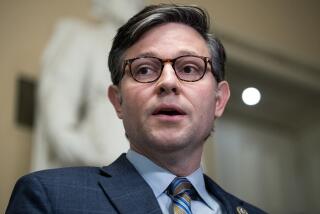The Savings Scandal
The rising indignation of taxpayers over the burden that they will bear in bailing out failed savings-and-loan institutions, and probably a number of banks as well, is understandable. The public has been betrayed by a culpability that runs from dilatory regulators and complacent bureaucrats in the executive branch of the federal government to a Congress eager to please the politically powerful masters of the thrift and banking industries.
As a result, there will be an inescapable cost of close to $100 billion that the taxpayers themselves will now be forced to pay over the next three or four years. The cost is inescapable because the good faith of the government must protect, within the prescribed limits of the law, the depositors placed at risk by the profligate mismanagement of so many thrifts and banks.
That outrageous cost may be just the beginning. Nothing that the Federal Home Loan Bank Board has done to address the crisis in the savings-and-loan industry is a remedy for the underlying problem. Indeed, critical elements of the generous and virtually risk-free deals being struck by the board with private investors, ostensibly to cut the cost to taxpayers for the rescue mission, raise a flood of questions about their equity and about the real commitment of the new investors to reform and a long-term role.
Furthermore, both Congress and the Reagan White House, through the Council of Economic Advisers, have been so busy blaming others that they have ignored their own glaring responsibility, including the responsibility to come up with real reforms. More, much more than a clean-up of management, is required.
Time is wasting. Even as regulators and legislators rush to their own defense, the problem is getting worse. Some of the FHLBB interventions have eased the interest rates that thrift institutions have to pay for new money. But they have not deterred a continued, perilous mounting of more liabilities at a time when the loans made by the troubled institutions already exceed the valuation of the projects for which they were made in the first place.
The collaboration of Federal Savings and Loan Insurance Corp. officials with megabuck bailout investors in the final days of December, to assure these investors a maximum tax benefit before the law changed on Jan. 1, raises serious questions for Congress to pursue. Federal regulators argue that these midnight deals were in the public interest. They also point out that they were given few options because FSLIC reserves had fallen to only a fraction of the obligations to depositors. It is now for Congress to find out whether the right thing was done.
But Congress itself will be ignoring the public interest if it fails to do more than conduct noisy hearings. This is not a Republican-Democratic partisan issue. The deregulation that is at the heart of the crisis was voted by Congress in the Carter Administration, then reinforced in the subsequent Reagan years. It would be ridiculous to maintain any federal role, any deposit insurance, unless regulations are restored to minimize the risks.To do otherwise would be to force taxpayers to pick up the losses of a financial sector more akin to a casino than the prudent institutions envisioned when deposit insurance was invented.
Furthermore, Congress must look sharply at the decision of the FHLBB that its function is to save the industry, not just to protect those with deposits up to the federal insurance limit of $100,000. Perhaps it is cheaper to reorganize failing institutions rather than to padlock their doors and pay off depositors. But Congress needs to know who this grand scheme will benefit beyond the insured depositors and the traditional customers of mortgage money.
The crisis has elicited expressions of outrage from the savings-and-loan institutions that are well managed and in strong condition. But their protests had been muted until Congress raised the prospect that all of the industry will have to bear an increased share in the costs of finding remedies, of refinancing the FSLIC. We see no alternative to continuing and probably enlarging the special FSLIC assessment paid by all savings-and-loans. That need not preclude introducing a risk-related supplementary insurance premium for the institutions that might choose to continue dubious investments.
Even as the savings-and-loan crisis takes center stage, unresolved problems are being compounded in the banking industry. The new federal budget includes warnings about the risky rush of major banks to fund leveraged buyouts of businesses--a highly profitable venture only so long as economic growth is maintained and recession is avoided.
A sensitive issue dims the likelihood of effective action on Capitol Hill. That is the cozy relationship between so many in Congress, including the leadership, and the thrift industry, which has been politically and financially helpful to them. There will be a temptation to continue coddling the industry at a time when it needs a reassertion of stringent controls. There will be a reluctance to reassess whether, in fact, savings-and-loan institutions should continue to have a protected place in the American economy today, long after they have diversified so broadly from their historic function of providing mortgages for home and commercial real estate.
In facing this crisis, Congress needs to remember what the public interest is. There is no public obligation to bail out investors, to reduce the risk of those rushing in with new money, to protect failed managers, to guard the stockholders of mismanaged companies. The public obligation is to protect the depositors within the limits of the law. And to see that it doesn’t happen again.
More to Read
Inside the business of entertainment
The Wide Shot brings you news, analysis and insights on everything from streaming wars to production — and what it all means for the future.
You may occasionally receive promotional content from the Los Angeles Times.










